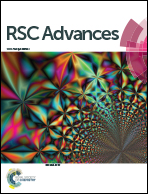Three-dimensionally ordered macroporous (3DOM) SiOC on a cordierite monolith inner wall and its properties for soot combustion†
Abstract
Three-dimensionally ordered macroporous (3DOM) SiOC was successfully fabricated on a cordierite monolith inner wall of a polystyrene (PS) sphere template through a colloidal crystal templating (CCT) method (named as 3DOM SiOC/cordierite). And perovskite-type LaCoO3 (LCO) mixed metal oxides, prepared by a facile sol–gel process, were coated onto the wall of the 3DOM SiOC/cordierite by a simple impregnation-sintering approach (named as LCO/3DOM SiOC/cordierite). The morphological and physicochemical properties studies indicate that the 3DOM structure has excellent connectivity, a large specific surface area, and applicable pore size. And the 3DOM structure plays an important role in preventing aggregation of the targeted catalyst particles, improving the contact condition between catalysts and soot as well as enhancing the reducibility of the LCO. The subsequent investigation on the catalytic performance of the 3DOM samples for diesel soot combustion shows that the 3DOM texture offers the catalyst a lower soot combustion temperature than a conventional catalyst, and the LCO/3DOM SiOC/cordierite reduces the combustion temperature even further while avoiding the rise of back-pressure effectively as well.


 Please wait while we load your content...
Please wait while we load your content...